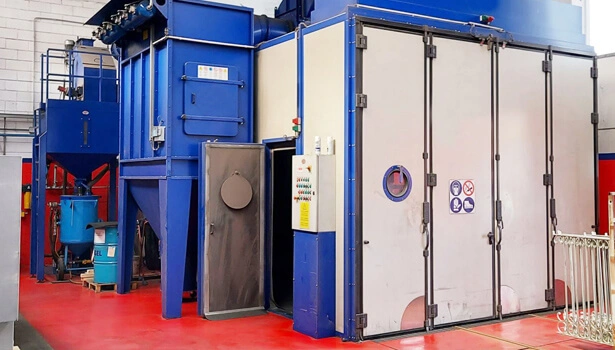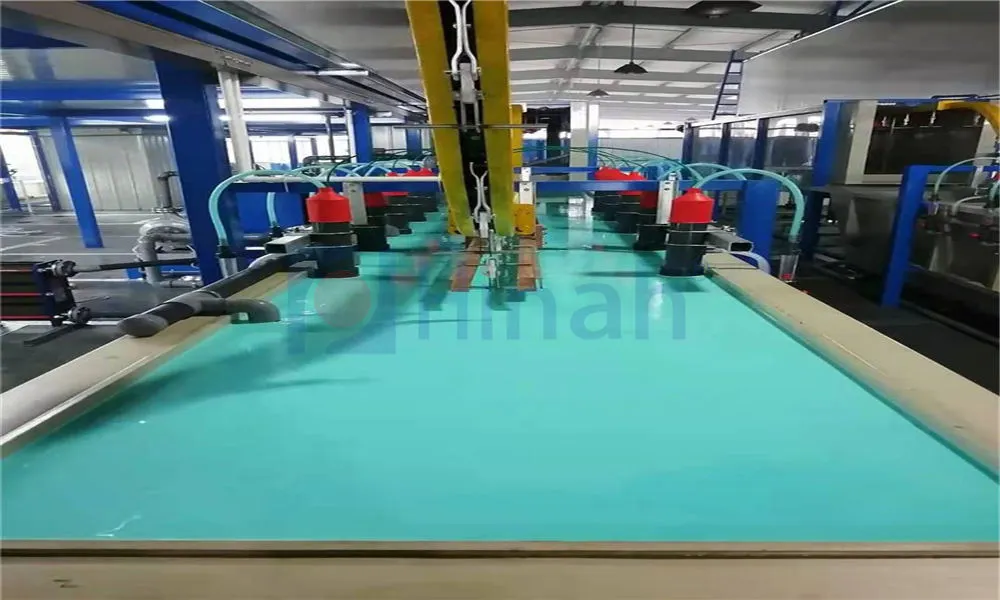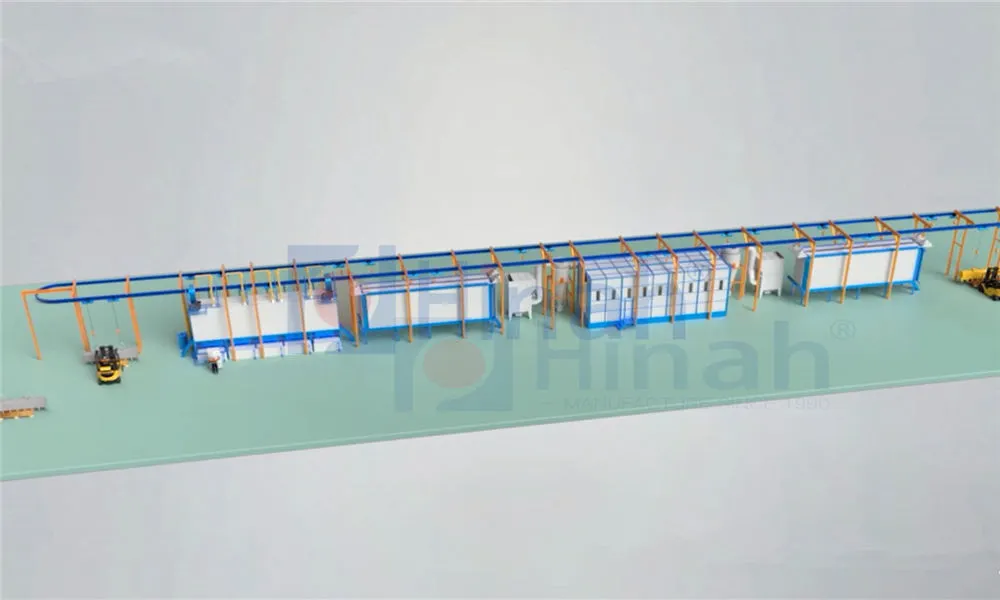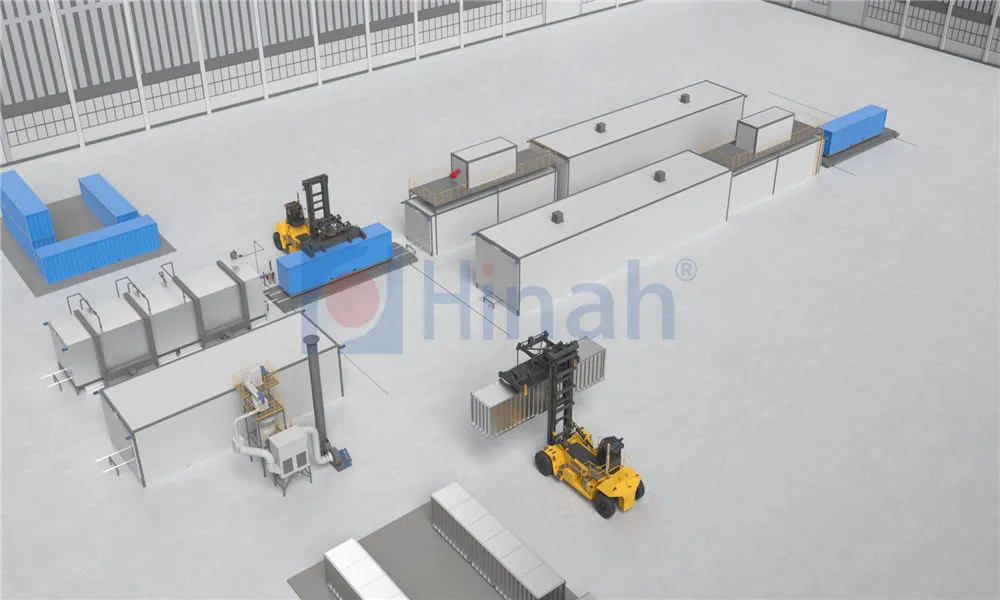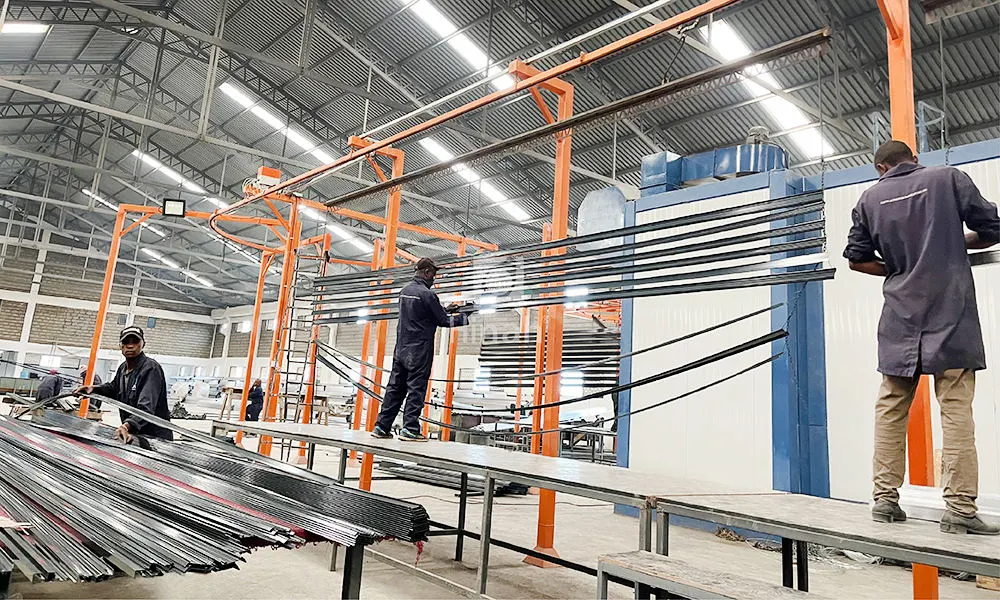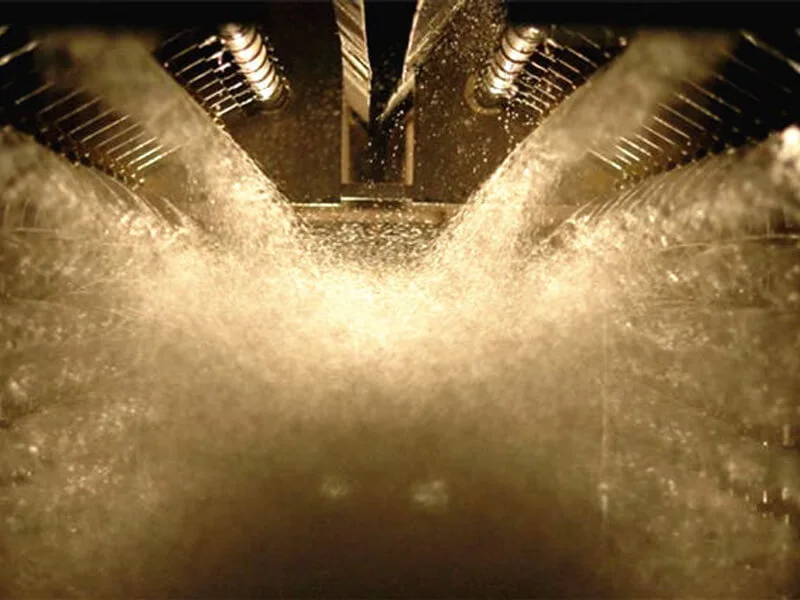In the demanding world of metal component manufacturing, particularly for castings, achieving exceptional corrosion protection, uniform coverage, and an aesthetically pleasing finish is paramount. This is where the Castings E-Coating Line becomes an indispensable technology. Also known as electrophoretic coating or electrocoating, this process has revolutionized how complex metal parts, especially intricate castings, are protected. This comprehensive guide delves deep into the Castings E-Coating Line, exploring its fundamentals, process steps, significant advantages, essential equipment, diverse applications, and critical operational considerations, providing a thorough understanding of why it's a cornerstone of modern finishing for cast components.
What is a Castings E-Coating Line? (The Fundamentals)
A Castings E-Coating Line is a highly automated, multi-stage industrial system specifically designed to apply a protective and decorative organic paint coating to metal castings using the principles of electrodeposition. The core technology leverages an electrical current to deposit paint particles uniformly onto a submerged, conductive part (the casting) from a water-based paint bath.
The Science: The e-coat bath contains charged paint particles (resins, pigments, additives) dispersed in water. When a direct current (DC) voltage is applied between the casting (acting as an electrode) and a counter-electrode in the tank, the charged particles migrate through the solution. They are deposited onto the casting's surface, where they lose their charge and form an initially water-soluble film. Subsequent curing (baking) transforms this film into a dense, cross-linked, highly adherent, and insoluble coating.
Why Castings? Castings often feature complex geometries, internal cavities, recesses, and sharp edges – areas notoriously difficult to coat uniformly using traditional spray methods. The Castings E-Coating Line excels here due to its unique throwing power. The electrical field enables the paint to wrap around corners and penetrate deep into recesses, ensuring consistent coverage even on challenging shapes and within hollow sections, minimizing the risk of corrosion starting in uncoated areas.
E-Coating Types: Primarily, Cathodic E-Coat (where the part is the cathode) dominates the market for corrosion protection, especially for ferrous castings (iron, steel). Anodic E-Coat (part as anode) is less common today due to generally inferior corrosion resistance. The focus of a typical Castings E-Coating Line is overwhelmingly on Cathodic Epoxy or Acrylic systems.
The Step-by-Step Process in a Castings E-Coating Line
A successful Castings E-Coating Line relies on a meticulously controlled sequence of stages, each critical to the final coating quality:
Pre-treatment: This is arguably the most crucial stage for castings. It typically involves:
Cleaning: Alkaline or acidic cleaners remove oils, greases, lubricants, and shop dirt accumulated during casting and machining. This often includes stages like soak cleaning and spray washing.
Rinsing: Multiple thorough rinses (often including deionized water rinses) remove cleaning chemicals and prevent contamination carryover.
Conversion Coating: This chemical treatment (commonly Zinc Phosphate or Iron Phosphate for ferrous castings, or Zirconium/Titanium-based for non-ferrous like aluminum) creates a micro-crystalline layer on the metal surface. This layer dramatically enhances the adhesion of the e-coat and provides an additional barrier against corrosion under the paint film. Rinsing follows this stage meticulously.
Final Rinse: Usually a deionized (DI) water rinse to ensure a pristine, contaminant-free surface before entering the e-coat tank. Poor pre-treatment leads directly to coating failures like blistering or peeling.
E-Coating Bath Immersion:
The meticulously pre-treated castings are lowered into the main e-coat bath tank.
A controlled DC voltage is applied for a specific dwell time (typically 2-4 minutes).
The charged paint particles migrate and deposit uniformly onto the casting surface. Film thickness is primarily controlled by voltage and time.
Post Rinses (Ultrafiltration - UF Rinses):
As parts exit the main bath, they carry a thin layer of uncoagulated, still water-soluble paint (called "dragout").
A series of rinse tanks, fed by ultrafiltrate (UF permeate) from the bath's integrated UF system, recover this valuable paint. These rinses (typically 2-4 stages, including a DI rinse) prevent paint waste, minimize contamination of subsequent baths, and improve surface appearance.
Drain & Drip: Parts are allowed to drain adequately to minimize liquid carryover into the oven.
Curing (Baking):
The rinsed parts enter a convection oven.
At elevated temperatures (typically 160°C - 190°C / 320°F - 375°F for 15-30 minutes, depending on the coating chemistry), the deposited film undergoes cross-linking (curing).
This transforms the water-soluble film into a hard, durable, chemically resistant, and fully adherent coating. Water and solvents are volatilized and exhausted.
Key Advantages of Using a Castings E-Coating Line
Investing in a Castings E-Coating Line offers numerous compelling benefits over alternative finishing methods:
Exceptional Corrosion Resistance: This is the primary driver. E-coat films provide outstanding barrier protection, often exceeding 500 hours of salt spray resistance (ASTM B117) or more when applied over proper pre-treatment, making them ideal for demanding automotive, agricultural, and outdoor applications.
Superior Uniformity & Coverage: The electrophoretic process ensures uniform film thickness distribution, even on complex shapes, sharp edges, recesses, and internal surfaces that are difficult or impossible to coat effectively with spray methods. This eliminates weak spots prone to corrosion.
Unmatched Throwing Power: The electrical field enables the paint to penetrate deep into cavities, box sections, and around corners, coating areas inaccessible to spray guns. This is a game-changer for intricate castings.
High Material Utilization & Low Waste: The e-coat process is highly efficient. Overspray is virtually eliminated (unlike spray painting). Paint not deposited remains in the bath. UF rinse systems recover up to 98% of dragout paint, minimizing waste and lowering material costs. It's environmentally favorable.
Excellent Adhesion: The combination of thorough pre-treatment (conversion coating) and the electrochemical deposition mechanism results in superb coating adhesion to the metal substrate.
Automation & Consistency: Castings E-Coating Lines are highly automated, allowing for precise control over process parameters (voltage, time, temperature, chemistry). This ensures consistent, repeatable, high-quality results batch after batch, reducing rejects.
Smooth, Aesthetic Finish: E-coat provides a smooth, uniform surface that serves as an excellent foundation for topcoats (if used) or can be a functional and attractive finish itself.
Environmental Benefits: Modern e-coats are water-based, significantly reducing VOC (Volatile Organic Compound) emissions compared to solvent-borne paints. Closed-loop rinse systems minimize water consumption.
*Table 1: E-Coating vs. Alternative Casting Finishing Methods*
Feature Castings E-Coating Line Traditional Liquid Spray Powder Coating
Coverage on Complex Shapes/Internals Excellent (Throwing Power) Poor to Fair Fair to Good (Faraday Cage issues)
Film Uniformity Excellent Variable Good (except recesses)
Material Efficiency Very High (>95%) Low (30-70%) High (95%+)
Corrosion Resistance Excellent Good (depends on system) Good to Excellent
Environmental (VOCs) Low (Water-based) High (Solvent-based) Very Low (Solvent-free)
Edge Coverage Excellent Often Thin Good
Automation Level High Moderate to High High
Initial Investment High Moderate Moderate to High
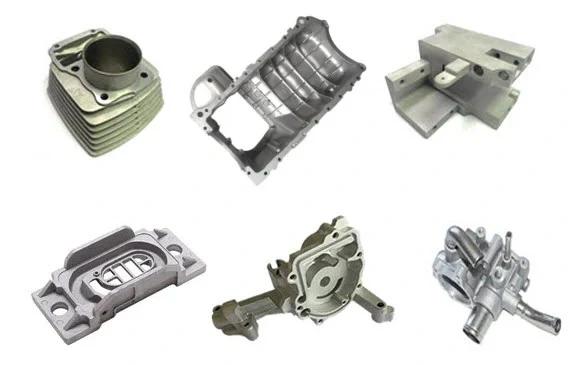
Essential Equipment in a Modern Castings E-Coating Line
A robust Castings E-Coating Line comprises several integrated subsystems:
Material Handling System: This is the backbone, transporting castings through all stages. Common types include:
Overhead Conveyors (Power & Free or Continuous): Highly versatile, allowing for variable speed and accumulation between stages. Essential for complex lines.
Monorail Systems: Simpler, often used for lower-volume or specialized applications.
Shuttle Systems: Suitable for batch processing.
Fixtures and racks are critical to securely hold castings, ensure good electrical contact, and allow proper drainage/coverage.
Pre-treatment Stages: Multiple tanks (typically 6-10 or more) for cleaning, rinsing, conversion coating, and final rinsing. Includes:
Tanks (steel, lined steel, or polypropylene)
Immersion heaters or heat exchangers
Spray nozzles and pumps (for spray stages)
Filtration systems
Chemical dosing and control systems (pH, conductivity, concentration)
Mist collectors and exhaust
E-Coat Application System:
Main E-Coat Tank: Large tank constructed from lined steel or special plastics to resist the coating chemistry. Includes agitation (pumps, eductor nozzles) to maintain suspension and temperature control (chillers/heaters).
Rectifiers: High-amperage DC power supplies providing the critical voltage for deposition. Precise control is vital.
Electrodes (Anodes/Cathodes): Typically stainless steel or coated titanium, housed in membrane cells (CED) or as open anodes (AED). Membranes prevent gas and byproducts from contaminating the bath.
Ultrafiltration (UF) System: The heart of efficiency. Membrane filters separate the bath into permeate (clear water with small ions/solvents) and retentate (concentrated paint). Permeate feeds the post-rinse tanks; retentate is returned to the main tank.
Post E-Coat Rinse System: A cascade series of rinse tanks (RO/DI rinse often the final stage), fed by UF permeate. Equipped with spray manifolds, pumps, and often conductivity control.
Curing Oven: Large convection oven providing precise temperature control and uniform airflow to ensure complete curing of the coating. Efficient exhaust and thermal oxidizers (if needed) manage emissions.
Control System: A centralized PLC (Programmable Logic Controller) or DCS (Distributed Control System) monitors and controls all critical parameters (conveyor speed, tank temperatures, chemical concentrations, voltage, current, oven zones). Data logging is essential for quality traceability.
Ancillary Systems: DI water generation, waste treatment (for pre-treatment effluents), paint kitchen (for bath make-up and adjustment), exhaust air treatment (scrubbers, oxidizers), and quality control stations.
Applications: Where Castings E-Coating Lines Shine
Castings E-Coating Lines are the preferred finishing solution across numerous industries due to their unmatched combination of protection and coverage on complex parts:
Automotive:
Engine blocks and cylinder heads
Transmission cases and housings
Differentials and axle housings
Brake calipers and brackets
Steering knuckles and components
Suspension parts (control arms, knuckles)
Brackets and mounting hardware
Heavy Equipment & Agriculture:
Transmission and gearbox housings
Axle cases
Hydraulic valve bodies and manifolds
Engine components
Structural castings and brackets
Industrial Machinery:
Pump and compressor housings
Valve bodies
Gearbox casings
Motor end frames and housings
Machinery frames and brackets
Plumbing & Valves: Complex valve bodies and fittings.
Electrical: Motor housings, transformer parts (where applicable).
Consumer Durables: Components for appliances, lawn/garden equipment requiring high corrosion resistance.
Essentially, any critical casting exposed to harsh environments (corrosive chemicals, salts, weather) or requiring long-term reliability and aesthetic appeal benefits significantly from processing through a dedicated Castings E-Coating Line.
Critical Considerations for Operating a Castings E-Coating Line
Running a successful Castings E-Coating Line requires meticulous attention to several factors:
Pre-treatment Perfection: As emphasized earlier, this is non-negotiable. Consistent, effective cleaning and conversion coating are the absolute foundation for coating adhesion and performance. Regular monitoring and maintenance of pre-treatment chemistry are vital.
Bath Chemistry Management: The e-coat bath is a living system. Key parameters must be rigorously controlled:
Solids Content: Percentage of non-volatile material (resin, pigment).
pH: Critical for bath stability and deposition characteristics.
Conductivity: Measures ionic strength, affecting throwing power.
P/B Ratio (Pigment to Binder): Impacts color, gloss, and properties.
MEQ (Milliequivalents): Acid/base content impacting deposition and stability.
Temperature: Affects viscosity, deposition rate, and bath stability.
Regular titrations, additions of feed stock, and adjustments based on production are essential.
UF System Health: The UF system maintains bath balance and enables efficient rinsing. Membrane integrity, flux rates, and rejection rates must be monitored. Regular cleaning (CIP - Clean In Place) is mandatory.
Voltage & Current Control: Precise control by the rectifier is crucial for achieving target film build and uniformity. Amperage requirements can be high, especially for large or dense loads of castings.
Racking & Fixturing: Parts must be racked securely to prevent movement, ensure good electrical contact, and allow complete drainage and coating access. Poor racking causes coating defects and inefficiencies. Fixtures need periodic stripping.
Curing Profile: Ensuring the coating reaches the correct peak metal temperature (PMT) for the required time is essential for achieving full cure and optimal properties. Oven temperature uniformity and tracking are critical.
Troubleshooting Common Defects: Operators must be skilled in identifying and resolving issues like:
Craters/Fish Eyes: Usually caused by oil contamination (pre-treatment failure).
Poor Coverage in Recesses: Low voltage, low bath conductivity, short dwell time, or improper racking (Faraday cage effect).
Rough Film (Orange Peel): Often related to bath parameters (solids, temperature) or improper curing.
Blistering: Typically moisture or solvent entrapment, or under-cure; can also stem from poor pre-treatment or phosphate issues.
Low Film Build: Insufficient voltage or time.
High Film Build/Overbake: Excessive voltage/time or curing temperature/time.
Conclusion
The Castings E-Coating Line represents a sophisticated, efficient, and highly effective finishing technology specifically engineered to overcome the challenges of protecting complex metal castings. Its unparalleled ability to deliver uniform, high-performance corrosion protection to every nook, cranny, and internal passageway – coupled with high material utilization, environmental benefits, and process consistency – makes it an indispensable solution for industries demanding the utmost in component durability and reliability. From automotive drivetrains to heavy-duty industrial machinery, the Castings E-Coating Line provides the foundational coating that ensures these critical components withstand the test of time and harsh operating environments. Understanding the process intricacies, equipment requirements, and operational discipline involved is key to leveraging the full potential of this remarkable technology for superior casting finishing. Investing in and optimizing a Castings E-Coating Line is an investment in product quality, longevity, and customer satisfaction.



